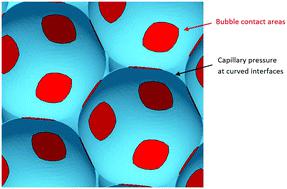当前位置:
X-MOL 学术
›
Soft Matter
›
论文详情
Our official English website, www.x-mol.net, welcomes your feedback! (Note: you will need to create a separate account there.)
Capillary pressure, osmotic pressure and bubble contact areas in foams
Soft Matter ( IF 3.4 ) Pub Date : 2021-07-09 , DOI: 10.1039/d1sm00823d Reinhard Höhler 1 , Jordan Seknagi 2 , Andrew Kraynik 3
Soft Matter ( IF 3.4 ) Pub Date : 2021-07-09 , DOI: 10.1039/d1sm00823d Reinhard Höhler 1 , Jordan Seknagi 2 , Andrew Kraynik 3
Affiliation

|
The capillary pressure of foams and emulsions is the difference between the average pressure in the dispersed phase and the pressure in the continuous phase. The pressure difference between individual bubbles or drops and the continuous phase is due to interfacial tension, and governs the thickness of films that separate neighbouring particles. Princen and Derjaguin presented an analytic relation, validated for ordered monodisperse foams with face-centered cubic (fcc) structure, that links the capillary pressure to osmotic pressure; they conjectured that it also held for disordered polydisperse foams that are encountered more frequently in nature and applications. Their conjecture is widely accepted. We derive their relation from first principles, and use known empirical expressions for the osmotic pressure to obtain analytic predictions for the capillary pressure and the average bubble contact area in a foam over the full range of liquid fractions. These results are validated using Surface Evolver simulations and previous experimental data. They also apply to emulsions.
中文翻译:

泡沫中的毛细管压力、渗透压和气泡接触面积
泡沫和乳液的毛细管压力是分散相中的平均压力与连续相中的压力之差。单个气泡或液滴与连续相之间的压差是由界面张力引起的,并控制着分隔相邻颗粒的薄膜的厚度。Princen 和 Derjaguin 提出了一种解析关系,验证了具有面心立方 (fcc) 结构的有序单分散泡沫,将毛细管压力与渗透压联系起来;他们推测,它也适用于在自然界和应用中更常见的无序多分散泡沫。他们的猜想被广泛接受。我们从第一原理推导出它们的关系,并使用渗透压的已知经验表达式来获得毛细管压力和泡沫在整个液体部分范围内的平均气泡接触面积的分析预测。这些结果使用 Surface Evolver 模拟和以前的实验数据进行了验证。它们也适用于乳液。
更新日期:2021-07-09
中文翻译:

泡沫中的毛细管压力、渗透压和气泡接触面积
泡沫和乳液的毛细管压力是分散相中的平均压力与连续相中的压力之差。单个气泡或液滴与连续相之间的压差是由界面张力引起的,并控制着分隔相邻颗粒的薄膜的厚度。Princen 和 Derjaguin 提出了一种解析关系,验证了具有面心立方 (fcc) 结构的有序单分散泡沫,将毛细管压力与渗透压联系起来;他们推测,它也适用于在自然界和应用中更常见的无序多分散泡沫。他们的猜想被广泛接受。我们从第一原理推导出它们的关系,并使用渗透压的已知经验表达式来获得毛细管压力和泡沫在整个液体部分范围内的平均气泡接触面积的分析预测。这些结果使用 Surface Evolver 模拟和以前的实验数据进行了验证。它们也适用于乳液。



























 京公网安备 11010802027423号
京公网安备 11010802027423号